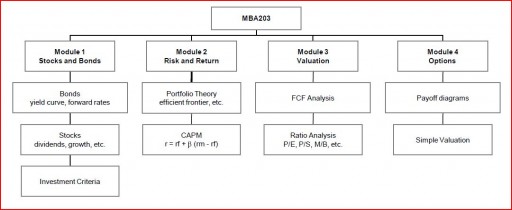上学期的后半学期(10月22日到12月10日,7周左右)上了四门必修课,其中比较重、也很定量的一门课是 MBA 203 Introduction to Finance. 顾名思义,这是一门金融学的导论。
老师
教我那个班的老师是 Gregory La Blanc:
他自己貌似是法学背景的:
BA, History/Economics/Philosophy, University of Pennsylvania
BS, Political Science, Wharton School, University of Pennsylvania
ABD, Financial History, University of Pennsylvania
JD, George Mason University
LLM Program, Boalt Hall School of Law, UC Berkeley.
他讲课讲的很好,拿了 2009年的两个 teaching 方面的奖:
UC Berkeley Presidential Teaching Fellow, 2009
Earl F. Cheit Award for Outstanding Teaching, 2009
教学方式和课本:
这门课的大纲列了一本推荐的教科书:Principles of Corporate Finance, 9th Edition, by Richard A. Brealey, Stewart C. Myers and Franklin Allen, published by Irwin McGraw-Hill, 2008. 这本书的三位作者分别来自 London Business School, MIT Sloan School of Management 和 The Wharton School, University of Pennsylvania.
教学方式基本上是 lecture 为主,偶尔有一些小case. 每堂课 La Blanc 老师都有很多 slides,课后也有很多作业,大多数是定量的要计算的题目……
课程内容:
这门课的大纲(Syllabus)里面说:
This is an introductory MBA course in finance. Students learn how to value assets given forecasts of future cash flows. The course also concentrates on the risk characteristics of different asset classes.
- The first part of the course focuses on bonds and stocks.
- The second part of the course deals with measuring and pricing risk.
- The third part of the course introduces students to valuation.
- The final part of the course introduces students to derivative instruments.
A concurrent goal of this course is to get students interested in finance and encourage them to take elective courses in finance (there is a large offering of finance electives at Haas.)
对我这样从未学过 finance 的人来说,这门课基本上是扫盲,在短短七周里学了很多以前完全不懂的概念:
- Valuing a Project and the NPV (Net Present Value) Rule
- Compound Interest and PV Calculations (Perpetuity, Annuity, Growing Perpetuity, Growing Annuity)
- Interest Rates – EAR (Effective Annual Rate) vs. APR (Annual Percentage Rate), Nominal Interest Rate vs. Real Interest Rate
- Bonds (face value/par value, coupon payment, Yield to Maturity (YTM), Forward Rates)
- Stocks (Dividend Growth Model, Internal Rate of Return (IRR) )
- Portfolio Theory and the Capital Asset Pricing Model (CAPM), the Beta.
- the Adjusted Presented Value (APV) method and the Weighted Average Cost of Capital (WACC) method.
Finance 还是很重要的。正如老师在第一节课说的:
Finance is about capital allocation.
Capital is the lifeblood of everything in economics.
Activities and entities that get capital grow, those starved of it die.
所以我想,到了二年级,我会再选一些 finance 方面的选修课吧。

